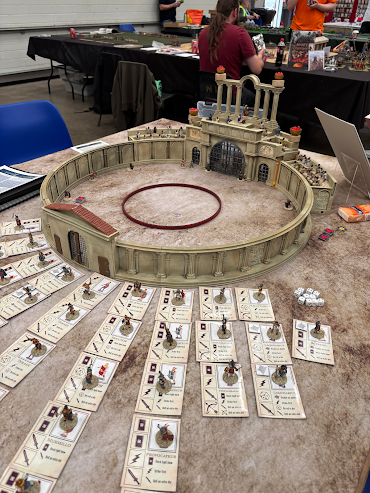Before we start let’s just park my dodgy dad jokes about black eye liner and black clothes right here shall we? Good call, as this post actually came about as I tried to decide what colours to paint some Baccus 6mm gothic infantry and led to a bit of an argument from Google's wonderful (not wonderful in the least) AI assistant. Again no jokes about needing to buy more black paint eh? More on the failings of AI later.
 |
| Goths, or Vandals or Ostrogoths and even possibly Visigoths |
We don't have a huge amount of information on the earliest Gothic people and there is a still some “healthy” debate as to where they originated. Most of our sources come from the 'civilised' peoples around the Mediterranean and have to be taken with a pinch of salt as they tended to be biased about the hairy barbarian types beyond the frontiers! The usual wargaming view is that Goths come in two flavours Visigoths and Ostrogoths (aka Tervingi and Greuthingi). However, the Romans just called them all Goths until Attila's time, as they didn’t really have any information on the sub-divisions amongst them. It wasn’t until after the fall of the Western Roman Empire that the term Visigoths came into use so that term isn't entirely useful either. I'd say that they are Goths, then Goths and Ostrogoths then Visigoths and Ostrogoths once the Toulousean Kingdom is established in the mid 5th Century
The Goth's first came to the attention of the wider world while living in modern Ukraine in the area either side of the Dneiper River. by the time that Jordanes was writing in the 5th century the Goths themselves seem to have believed that they originally came from an island far to the north of the Ukraine. That gives rise to the idea that they originated in Scandinavia supported by the names of areas in Southern Sweden like Gothenburg and Gotland. However this may be a bit of a stretch, it's like suggesting that the town of Reading had ancient inhabitants who liked to peruse the written word more than their neighbours! Still there is some archaeological evidence of a people related to the Goths and Vandals moving south through Poland and Western Russia. For this period there is no solid evidence for the appearance of the Goths other than some grave goods.
Once in the Dneiper region the Vandals seem to have settled to the north of the Goths and the Goths them selves to have divided into the Tervingi west of the Dneiper and the Greuthingi to the east. They seem to have taken over some Alannic terriotory splitting the Alans into a western and an eastern group. What we do know is that a large proportion of the Tervingi moved ahead of the expanding horse tribes displacing the Carpi (a remnant Dacian people) in Transylvania on the way and ultimately bumping into the Roman frontier in the first part of the third century. The remainder of the Goths and the eastern Alans became subjects of the Hunnic empire and eventually moved west along with them.
So what has the above Tourists guide to Europe for travelling barbarians got to do with the appearance of the Goths? Well in part their appearance is connected to the people they met and intermarried along the way. The Ostrogoths stayed in Hunnic territory and probably mixed with both Alanni and Hunnic types and possibly Heruls and Gepids. The Visigoths on the other hand moved into the area occupied by the Carpi and so picked up some Dacian genomes before moving further along the frontier and mixing with other Germanic peoples.. Eventually they joined with the Vandals in Spain and North Africa as well as that part of the Alans who had also moved west ahead of the Huns.
We have some documentary evidence that suggests that the Goths favoured furs and animal skins over 'civilised' clothing. I have read some sources which state that they carried their swords hanging from a baldrick type shoulder belt rather than suspending them from a belt Roman style. Shields were round or oval. I noted that the coffin style shield is not mentioned. One source mentions green cloaks with red edges as being popular. All of the images show them as wearing late Roman style tunics and trousers as a base layer. Lastly there is some archaeological evidence suggesting that some Goth's took up the steppe nomad practice of skull binding.
I was initially interested in hair colour and this is where Google's AI comes into the story. This tells me that the Goths were generally fair haired, being blonde, light brown or red brown hair coloured. It also states that Visigoths were also fair haired. Ask about Ostrogoths and the confusion starts. The Ostrogoths, it tells me were dark haired with mostly dark browns and black predominating. What it doesn't do is say what the source of that information is or for what period this covers. I kind of get the feeling that the AI doesn't rank information sources by quality when deciding what to report but rather goes with quantity of supporting web sites (be they good, bad or indifferent). I couldn't find any detailed information regarding shield patterns and or colours either so its going to be guess work for that.
So I decided on mostly fair haired tones with linens and mainly subdued natural coloured clothing with an above average (for my painting) amount of green tunics and cloaks. Shields will be derived from later Roman patterns especially those associated with Goths, Vandals and Alans. So at least the Goths are progressing (probably westwards in some haste!).
























